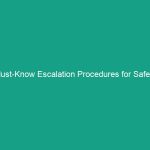Introduction
In today’s diverse work environments, ensuring the health and Safety of employees is paramount. Among various risks, exposure to bloodborne pathogens poses a significant threat, particularly in healthcare settings, emergency services, and industries involving potential blood contact. Preventing bloodborne pathogen exposure is not only a regulatory requirement but also a crucial aspect of Workplace Safety that safeguards employees and the community. This article aims to provide comprehensive insights into effective strategies for minimizing exposure to these pathogens, ensuring compliance with regulatory frameworks, and fostering a culture of Safety.
Understanding Bloodborne Pathogens
Before diving into Prevention strategies, it’s essential to understand what bloodborne pathogens are and why they pose a risk. Bloodborne pathogens are microorganisms found in human blood that can cause disease in humans. The most common types include:
- HIV (Human Immunodeficiency Virus)
- HBV (Hepatitis B Virus)
- HCV (Hepatitis C Virus)
These pathogens can be transmitted through blood and other potentially infectious materials (OPIM), such as certain body fluids. Understanding the modes of transmission is crucial in preventing bloodborne pathogen exposure. For instance, exposure can occur through:
- Needle sticks or other sharps injuries
- Open wounds contacting contaminated fluids
- Mucous membrane exposure (e.g., eyes, mouth)
Regulatory Frameworks
Various Regulations govern the handling and exposure to bloodborne pathogens, primarily through the Occupational Safety and Health Administration (OSHA). The osha Bloodborne Pathogens Standard (29 CFR 1910.1030) outlines crucial requirements for employers to protect employees from potential exposure. Key components of this standard include:
- Exposure Control Plans: Employers must develop and implement a written exposure control plan that outlines how they will minimize risks.
- Training: Employees must receive Training on the Hazards associated with bloodborne pathogens and the Procedures to follow.
- PPE (Personal Protective Equipment): Employers must provide appropriate PPE, such as gloves, gowns, and Eye Protection.
- Vaccination: Employers are required to offer the Hepatitis B vaccination to employees at risk.
By adhering to these regulations, organizations can significantly reduce the risk of exposure, thereby enhancing Workplace Safety and compliance.
Best Practices for Preventing Bloodborne Pathogen Exposure
Implementing effective Best Practices is vital for preventing bloodborne pathogen exposure. Here are some essential practices to consider:
1. Implementing an Exposure Control Plan
An effective exposure control plan is the cornerstone of any strategy aimed at reducing exposure risks. This plan should include:
- Identification of employees at risk of exposure
- Procedures for safe handling and disposal of sharps
- Emergency procedures for exposure incidents
Regularly reviewing and updating the plan ensures it remains relevant and effective.
2. Training and Education
Training is a critical component in preventing bloodborne pathogen exposure. Regular training sessions should cover:
- The nature of bloodborne pathogens and associated risks
- Safe work practices and procedures
- Correct use of PPE
- How to respond to exposure incidents
Interactive training methods, such as simulations and role-playing, can enhance understanding and retention of information.
3. Safe Work Practices
Employers should encourage safe work practices to minimize exposure risks. These practices include:
- Avoiding unnecessary exposure to blood and OPIM
- Using mechanical devices to handle sharps whenever possible
- Ensuring that work areas are well-maintained and free of Hazards
Promoting a culture of safety where employees feel empowered to voice concerns is also essential.
4. Proper Use of Personal Protective Equipment (PPE)
PPE serves as a critical barrier between employees and potential exposure. It is essential to select appropriate PPE based on the level of exposure risk. Common PPE items include:
- Gloves
- Gowns or aprons
- Face shields or goggles
- Respirators (if needed)
Training employees on the correct use and disposal of PPE is crucial for its effectiveness.
5. Safe Sharps Disposal
Improper disposal of sharps is a leading cause of exposure incidents. Organizations should provide clearly labeled sharps disposal containers that are:
- Accessible to all employees
- Sturdy and puncture-resistant
- Regularly emptied and replaced
Employees must be trained not to overfill sharps containers and to report any issues immediately.
6. Incident Reporting and Follow-Up
In the event of an exposure incident, prompt reporting and follow-up are essential. All employees should be aware of the reporting procedures, which should include:
- Notifying a supervisor or designated safety officer
- Seeking medical attention immediately
- Documenting the incident for further analysis
Following up on incidents allows organizations to address any gaps in their safety protocols and improve future prevention strategies.
Case Studies on Bloodborne Pathogen Exposure Prevention
Real-world case studies provide valuable insights into the effectiveness of various strategies for preventing bloodborne pathogen exposure. Below are two illustrative examples:
Case Study 1: Healthcare Facility Implementation
A large urban hospital faced high rates of needle-stick injuries among its staff. To combat this issue, the hospital implemented a comprehensive exposure control plan that included:
- Annual training for all staff on bloodborne pathogens
- Introduction of safety-engineered devices, such as retractable needles
- Regular audits of compliance with safety protocols
As a result, the hospital reported a 40% decrease in needle-stick injuries over two years, demonstrating the effectiveness of a proactive approach to safety.
Case Study 2: Emergency Services Response
An emergency services organization identified that its personnel were at high risk of exposure due to the nature of their work. The organization took several steps to enhance safety, including:
- Providing enhanced training focused on high-risk scenarios
- Implementing a buddy system for handling sharps
- Conducting regular debriefings after incidents to improve protocols
These initiatives led to a significant cultural shift regarding safety, with personnel reporting increased confidence in handling exposure risks.
Challenges in Preventing Bloodborne Pathogen Exposure
Despite the implementation of Best Practices and regulatory compliance, organizations often face challenges in preventing bloodborne pathogen exposure. Some common hurdles include:
1. Employee Complacency
As time passes, employees may become complacent about safety protocols, believing that accidents won’t happen to them. This mindset can lead to lapses in following safety procedures. Regular refresher training and reminders about the serious consequences of exposure can help combat complacency.
2. Resource Constraints
Smaller organizations may struggle to allocate sufficient resources for training, equipment, and compliance efforts. Seeking partnerships with local health departments or leveraging online training resources can provide cost-effective solutions.
3. Keeping Up with Regulatory Changes
The landscape of health and safety regulations is continually evolving. Staying informed about changes to the OSHA Bloodborne Pathogens Standard and other relevant regulations is crucial. Regularly consulting with HSE professionals and participating in industry forums can help organizations remain compliant.
Future Trends in Bloodborne Pathogen Prevention
As we look to the future, several trends are emerging in the realm of preventing bloodborne pathogen exposure. These trends include:
1. Technology Integration
The integration of technology into safety protocols is on the rise. This includes everything from electronic training modules to advanced sharps disposal systems that track usage and replacement. Such innovations can enhance compliance and safety.
2. Enhanced Employee Engagement
Organizations are recognizing the importance of fostering a culture of safety through employee engagement. Initiatives that encourage staff involvement in safety committees or feedback on protocols can lead to more effective prevention strategies.
3. Focus on Mental Health
Understanding the mental health implications of exposure incidents is gaining attention. Organizations are starting to provide support systems for employees who experience trauma from such events, ensuring a holistic approach to Workplace Safety.
Conclusion
Preventing bloodborne pathogen exposure is a critical aspect of Workplace Health and safety that requires commitment, training, and the implementation of best practices. By adhering to regulatory frameworks, fostering a culture of safety, and continuously educating employees, organizations can significantly reduce the risk of exposure. Remember, safety is a shared responsibility, and each individual plays a vital role in creating a safe working Environment. Let’s work together to ensure that preventing bloodborne pathogen exposure remains a top priority in all workplaces. Stay informed, stay safe, and don’t hesitate to reach out for help or resources if needed.


